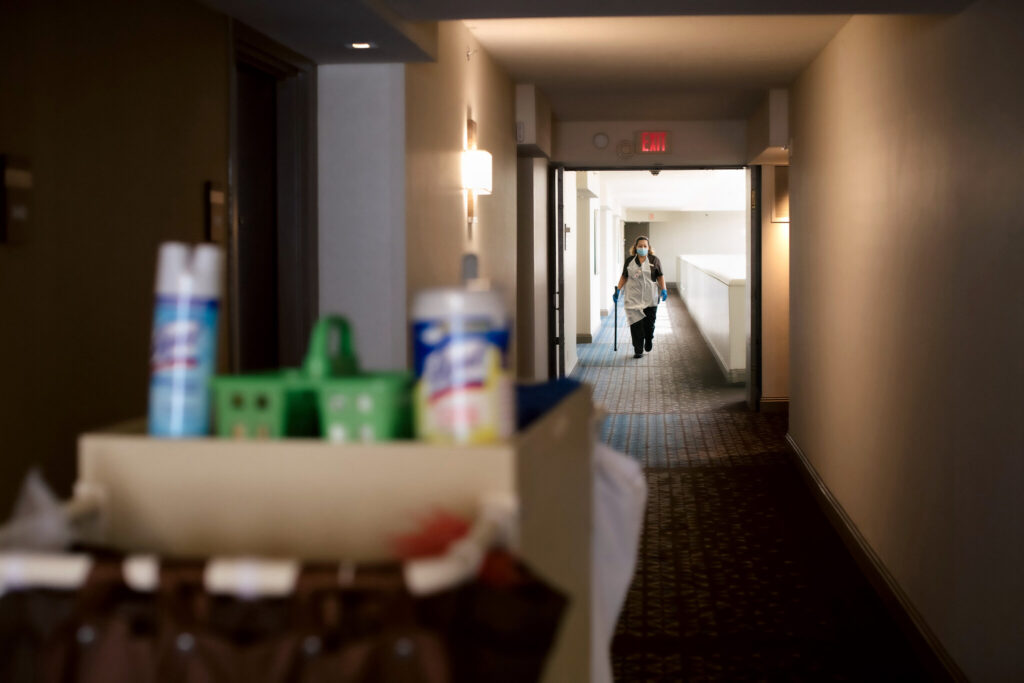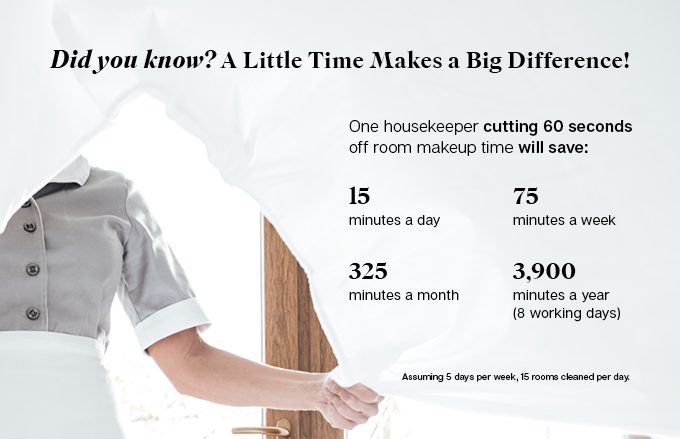Well, buckle up folks, because we’re about to embark on a wild journey through the world of housekeeping. In this delightful little article, we’ll be exploring just how much time those brave housekeepers are typically given to work their magic and make a room spotless. Get ready to have your mind blown as we reveal the average time that’s allotted for this challenging task. So sit back, relax, and prepare to be amazed by the secrets of the housekeeping universe. Trust us, you won’t want to miss a single word.
Factors Affecting Cleaning Time
Room Size
The size of a room is one of the key factors that affect the time it takes to clean it. Larger rooms obviously require more time and effort to clean compared to smaller ones. A spacious bedroom or living room with plenty of furniture and surfaces to dust and vacuum will take longer to clean than a compact bathroom or kitchen.
Number of Occupants
The number of occupants in a room also plays a role in determining the cleaning time. A room that is used by multiple people will naturally accumulate more dirt and mess, requiring additional time and effort to clean thoroughly. For example, a bedroom shared by two people will likely have twice as much clothing, bedding, and personal items to tidy up compared to a room occupied by only one person.
Level of Clutter
The level of clutter in a room can greatly impact the cleaning time. A room that is cluttered with items such as books, toys, and household items will require extra time to organize and declutter before the actual cleaning can commence. It’s important for housekeepers to efficiently manage clutter and find effective organization solutions to minimize cleaning time.
Type of Room
Different types of rooms have different cleaning requirements and therefore varying cleaning times. For instance, a bathroom typically requires more time and attention due to the need for thorough disinfection and scrubbing of fixtures. On the other hand, a kitchen may require more time for tasks such as dishwashing and cleaning appliances. Understanding the specific cleaning needs of each room is essential for accurate time estimation.
Tools and Equipment
Cleaning Supplies
To efficiently clean a room, housekeepers need a range of cleaning supplies such as all-purpose cleaners, disinfectants, glass cleaners, and specialized cleaning products. Having the right supplies easily accessible not only saves time but also ensures effective cleaning.
Vacuum Cleaner
A reliable vacuum cleaner is an essential tool for any housekeeper. It eliminates dust, dirt, and allergens from carpets, rugs, and floors quickly and efficiently. Investing in a quality vacuum cleaner with adequate suction power and maneuverability can significantly reduce cleaning time.
Mops and Brooms
Mops and brooms are necessary tools for floor cleaning. A housekeeper should have a variety of mop heads and broom types suitable for different floor surfaces. Microfiber mops are known for their efficiency in trapping dirt and dust, while brooms with fine bristles are effective for sweeping up loose debris.
Safety Equipment
Safety should always be a priority when carrying out cleaning tasks. Housekeepers should have access to appropriate safety equipment such as gloves, masks, goggles, and non-slip footwear. This not only ensures the well-being of the housekeeper but also enables them to work efficiently without fear of accidents or health hazards.

This image is property of static01.nyt.com.
Standard Cleaning Procedures
Dusting and Vacuuming
Dusting and vacuuming are foundational steps in any cleaning routine. Dusting surfaces, furniture, and decorative items not only improves the appearance of a room but also helps reduce allergens. Vacuuming, especially with a high-quality vacuum cleaner, efficiently removes dirt, dust, and debris from floors and carpets.
Mopping and Sweeping
Mopping and sweeping are essential for keeping floors clean and free of dirt and spills. Mops, combined with appropriate cleaning solutions, effectively remove sticky residues and stains from hard surfaces. Sweeping with a broom or a lightweight vacuum cleaner helps maintain cleanliness by removing loose dirt and debris.
Bathroom Cleaning
Bathroom cleaning requires attention to detail and thorough disinfection. Cleaning toilets, sinks, showers, and bathtubs removes dirt, grime, and bacteria. Additionally, wiping down mirrors and countertops and cleaning bathroom fixtures ensures a hygienic and pleasant environment.
Changing Linens
Changing linens, including bedding and towels, is an important part of maintaining cleanliness and hygiene in a room. Regularly washing and replacing linens not only improves the overall cleanliness of a room but also contributes to the comfort and well-being of its occupants.
Time Estimation Methods
Time and Motion Studies
Time and motion studies involve analyzing and observing the individual tasks involved in the cleaning process. By carefully observing and measuring the time it takes to perform each task, housekeeping managers can develop accurate time estimates and identify opportunities for improvement and efficiency.
Cleaning Experience
Experience plays a significant role in estimating cleaning times. Housekeepers who have years of experience tend to have more efficient techniques and methods, enabling them to complete tasks more quickly. However, it’s important to note that experience alone is not the sole determinant of cleaning time, as other factors can still influence the overall duration of the cleaning process.
Checklists and Guidelines
Using checklists and guidelines can help housekeepers stay organized and follow a consistent cleaning routine. These tools provide step-by-step instructions and ensure that no tasks are overlooked or forgotten. Following a checklist improves efficiency and helps housekeepers estimate the time required for each room accurately.

This image is property of static01.nyt.com.
Average Times for Different Rooms
Bedroom
The average cleaning time for a bedroom can vary depending on its size, level of clutter, and specific cleaning requirements. On average, it may take anywhere from 20 to 40 minutes to clean a standard-sized bedroom thoroughly. This includes tasks such as dusting surfaces, vacuuming or mopping floors, changing linens, and tidying up personal items.
Living Room
Similar to bedrooms, the cleaning time for a living room can vary depending on factors such as the room size, number of occupants, and level of clutter. On average, it may take approximately 30 to 60 minutes to clean a living room, including tasks like dusting and vacuuming furniture, cleaning electronics, and organizing any items that may be scattered around.
Bathroom
Bathrooms tend to require more time and attention compared to other rooms due to the need for thorough disinfection and deep cleaning. Depending on the size and specific cleaning needs, it may take around 30 to 60 minutes to clean a bathroom, including tasks like scrubbing toilets, cleaning surfaces, and wiping down mirrors.
Kitchen
Kitchens can be one of the most time-consuming rooms to clean due to the presence of appliances, countertops, and cooking areas that require thorough scrubbing and sanitization. On average, cleaning a kitchen may take around 40 to 90 minutes, including tasks such as washing dishes, wiping down surfaces, cleaning the stove and oven, and mopping the floor.
Quality Control Measures
Inspections
Regular inspections are crucial to maintaining high cleaning standards and ensuring that tasks are completed efficiently and effectively. Supervisors or quality control personnel can conduct inspections to identify any areas that require improvement or additional attention, allowing for timely feedback and corrective actions.
Training Programs
Investing in comprehensive training programs for housekeeping staff is essential for maintaining consistent cleaning standards and promoting efficiency. Properly trained staff members are more likely to perform tasks accurately and quickly, ultimately reducing overall cleaning time.
Feedback and Improvement
Establishing a culture of continuous improvement and providing feedback to housekeeping staff contributes to increased efficiency and productivity. Regular communication, both formal and informal, allows for the identification of potential areas for improvement and the implementation of measures to streamline cleaning processes.

This image is property of www.standardtextile.com.
Efficiency Tips for Housekeepers
Organizing Tasks
Prioritizing and organizing tasks can help housekeepers complete their work more efficiently. By categorizing tasks and planning out the most logical sequence, housekeepers can eliminate unnecessary backtracking and minimize time wasted on transitioning between different tasks.
Time Management
Effective time management is crucial for housekeepers to meet the demands of their workload. Setting realistic goals, breaking tasks into smaller manageable portions, and utilizing time management techniques such as the Pomodoro Technique can improve productivity and help complete cleaning tasks within allocated timeframes.
Optimizing Workflows
Analyzing and optimizing workflows allows housekeepers to identify bottlenecks and areas where processes can be streamlined. Progressive and smart workflow design, including the arrangement of cleaning supplies and tools, can significantly minimize the time and effort required to perform each task.
Scheduling and Workload
Factors Affecting Workload
Several factors can impact the workload of housekeepers, including the size and number of rooms to be cleaned, the level of occupancy, and the frequency of cleaning required. It’s important for employers to consider these factors when determining the appropriate workload for their housekeeping staff.
Shift Length and Breaks
The length of a housekeeper’s shift and the availability of scheduled breaks can have a significant impact on their efficiency and overall cleaning time. Providing adequate rest periods and ensuring reasonable shift durations allows housekeepers to maintain productivity and perform tasks effectively.
Flexible Scheduling
Introducing flexible scheduling options can help housekeepers manage their workload more efficiently. This allows them to navigate peak cleaning periods effectively and allocate their time and resources based on the specific needs of each room and its occupants.

This image is property of www.standardtextile.com.
Legal Requirements and Employment
Minimum Wage
Housekeeping staff, like all workers, are entitled to receive at least the minimum wage as determined by current labor laws. Employers must comply with minimum wage regulations to ensure fair compensation for housekeepers’ time and effort.
Overtime Compensation
When housekeepers work beyond their regular hours, they are entitled to receive overtime compensation as per applicable labor laws. Employers must adhere to these regulations to ensure fair compensation and promote a healthy work-life balance for their housekeeping staff.
Work Hour Regulations
Employers must comply with work hour regulations to ensure that housekeepers are not overworked or subjected to excessive physical or mental stress. Following these regulations helps maintain the well-being and safety of housekeeping staff while ensuring efficient and effective cleaning operations.
Conclusion
In conclusion, the average time given for a housekeeper to clean a room depends on various factors, including the size of the room, the number of occupants, the level of clutter, and the specific cleaning requirements. By considering these factors and utilizing efficient cleaning techniques, housekeepers can complete their tasks effectively and ensure a clean and organized environment for occupants. Additionally, implementing quality control measures, providing adequate training, and promoting efficiency tips can contribute to reducing cleaning times and improving overall productivity. Ultimately, finding the right balance between workload, scheduling, and legal requirements is essential in optimizing housekeeping operations and ensuring the well-being of housekeeping staff.
This image is property of www.usatoday.com.


